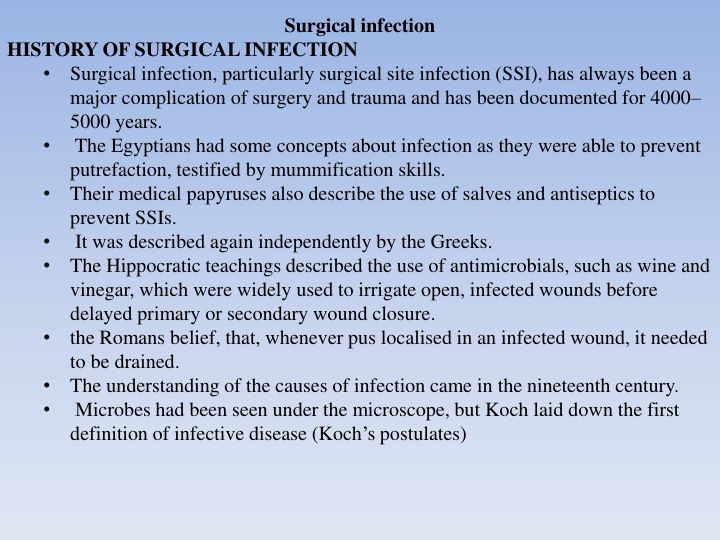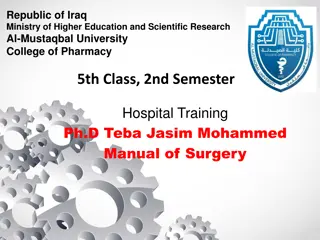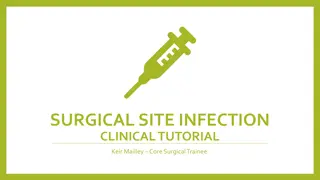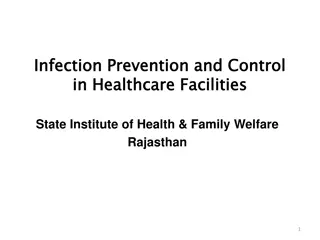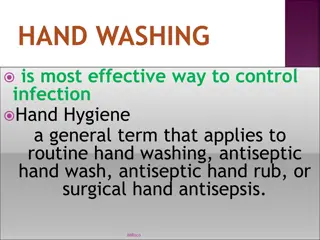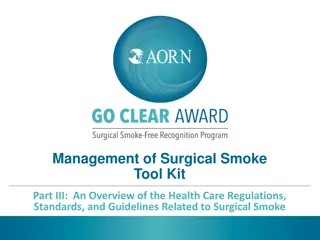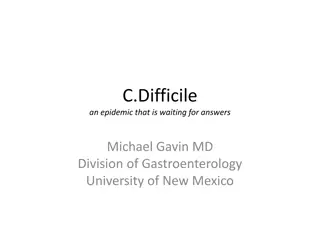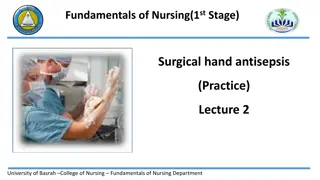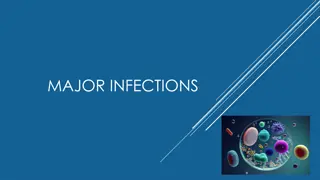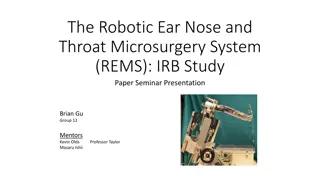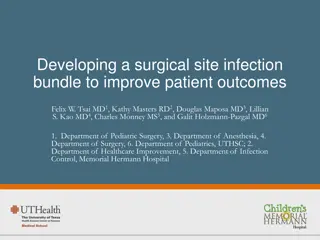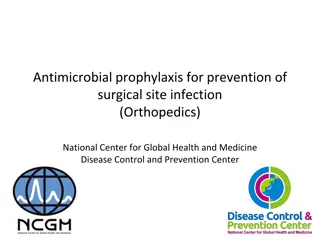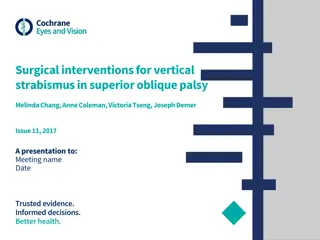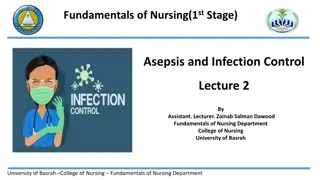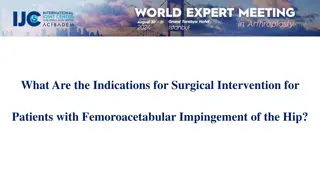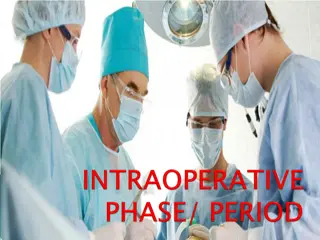Surgical infection
Surgical infection, particularly surgical site infection (SSI), has been a major complication of surgery and trauma for thousands of years, with advancements in understanding and control evolving over time. This history includes ancient practices by Egyptians and Greeks, the contributions of Koch and Pasteur, the discovery of antibiotics like penicillin, the rise of antibiotic resistance, and modern techniques such as aseptic surgery. These developments have significantly impacted surgical outcomes and patient care.
Download Presentation

Please find below an Image/Link to download the presentation.
The content on the website is provided AS IS for your information and personal use only. It may not be sold, licensed, or shared on other websites without obtaining consent from the author.If you encounter any issues during the download, it is possible that the publisher has removed the file from their server.
You are allowed to download the files provided on this website for personal or commercial use, subject to the condition that they are used lawfully. All files are the property of their respective owners.
The content on the website is provided AS IS for your information and personal use only. It may not be sold, licensed, or shared on other websites without obtaining consent from the author.
E N D
Presentation Transcript
Surgical infection HISTORY OF SURGICAL INFECTION Surgical infection, particularly surgical site infection (SSI), has always been a major complication of surgery and trauma and has been documented for 4000 5000 years. The Egyptians had some concepts about infection as they were able to prevent putrefaction, testified by mummification skills. Their medical papyruses also describe the use of salves and antiseptics to prevent SSIs. It was described again independently by the Greeks. The Hippocratic teachings described the use of antimicrobials, such as wine and vinegar, which were widely used to irrigate open, infected wounds before delayed primary or secondary wound closure. the Romans belief, that, whenever pus localised in an infected wound, it needed to be drained. The understanding of the causes of infection came in the nineteenth century. Microbes had been seen under the microscope, but Koch laid down the first definition of infective disease (Koch s postulates)
Organisms of low virulence may not cause disease in normal hosts but may be responsible for disease in immunocompromised hosts. Some hosts may develop subclinical disease and yet still be a carrier of the organism capable of infecting others. Not every organism that causes disease can be grown in culture. Louis Pasteur recognised through his germ theory that microorganisms were responsible for infecting humans and causing disease. The principles of antiseptic surgery were soon enhanced with aseptic surgery at the turn of the century. As well as killing the bacteria on the skin before surgical incision (antiseptic technique), the conditions under which the operation was performed were kept free of bacteria (aseptic technique). This technique is still employed in modern operating theatres. The discovery of the antibiotic penicillin is attributed to Alexander Fleming in 1928, but it was not isolated for clinical use until 1941 by Florey and Chain.
Many staphylococci today have become resistant to penicillin. Often bacteria develop resistance through the acquisition of b-lactamases, which break up the b-lactam ring present in the molecular structure of many antibiotics. The acquisition of extended spectrum b-lactamases (ESBLs) is an increasing concern in some gram-negative organisms that cause urinary tract infections because it is difficult to find an antibiotic effective against them. In addition, there is increasing concern about the rising resistance of many other bacteria to antibiotics, in particular the emergence of methicillin-resistant Staphylococcus aureus (MRSA) and glycopeptide-resistant enterococci (GRE), which are also relevant in general surgical practice. The introduction of antibiotics for prophylaxis and for treatment, together with advances in anaesthesia and critical care medicine, has made possible surgery that would not previously have been considered.
Kochs postulates proving whether a given organism is the cause of a given disease It must be found in every case It should be possible to isolate it from the host and grow it in culture It should reproduce the disease when injected into another healthy host It should be recovered from an experimentally infected host Advances in the control of infection in surgery Aseptic operating theatre techniques have enhanced the use of antiseptics Antibiotics have reduced postoperative infection rates after elective and emergency surgery Delayed primary, or secondary, closure remains useful in contaminated wounds
MICROBIOLOGY OF SURGICAL INFECTION Common bacteria causing surgical infection Streptococci Streptococci form chains and are Gram positive. The haemolytic Streptococcus, which resides in the pharynx of 5 10 per cent of the population. Streptococcus pyogenes, that is the most pathogenic. It has the ability to spread, causing cellulitis, and to cause tissue destruction through the release of enzymes such as streptolysin, streptokinase and streptodornase. Streptococcus faecalis is an enterococcus. It is often found in synergy with other organisms, as is the g-haemolytic Streptococcus and Peptostreptococcus, which is an anaerobe. Both Streptococcus pyogenes and Streptococcus faecalis may be involved in wound infection after large bowel surgery, but the a-haemolytic Streptococcus viridans is not associated with wound infections. All the streptococci remain sensitive to penicillin and erythromycin. The cephalosporins are a suitable alternative in patients who are allergic to penicillin.
Staphylococci Staphylococci form clumps and are Gram positive. Staphylococcus aureus is the most important pathogen in this group and is found in the nasopharynx of up to 15% of the population. It can cause suppuration in wounds and around implanted prostheses. Some strains are resistant to many common antibiotics (especially methicillin resistant Staphylococcus aureus, MRSA) and so are difficult to treat. MRSA can be found in the nose of asymptomatic carriers amongst both patients and hospital workers, a potential source of infection after surgery. In parts of northern Europe, the prevalence of MRSA infections has been kept at very low levels using search and destroy methods, which use screening techniques to look for MRSA in patients before they come in to hospital for elective surgery so that any carriers can be treated before their admission for surgery. Local policies on the management of MRSA depend on the prevalence of MRSA, the type of hospital, the clinical specialty and the availability of facilities. Widespread swabbing, ward closures, isolation of patients and disinfection of wards by deep cleaning all have to be carefully considered.
Staphylococcal infections are usually suppurative and localised. Most hospital Staphylococcus aureus strains are now b-lactamase producers and so are resistant to penicillin, but many strains remain sensitive to flucloxacillin, vancomycin, aminoglycosides and some cephalosporins. There are several novel and innovative antibiotics becoming available that have high activity against resistant strains. Some have the advantage of good oral activity (linezolid), some have a wide spectrum (teicoplanin), some have good activity in bacteraemia (daptomycin) but all are relatively expensive, and some have side effects involving marrow, hepatic and renal toxicity. Their use is justified but needs to be controlled by tight local policies and guidelines that involve clinical microbiologists. Staphylococcus epidermidis (previously Staphylococcus albus), also known as coagulase-negative staphylococcus, was regarded as a non-pathogenic commensal organism commonly found on the skin, but is now recognised as a major threat in vascular and orthopaedic prosthetic surgery and in indwelling vascular cannulas/catheters. The bacteria form biofilms which adhere to prosthetic surfaces and limit the effectiveness of antibiotics.
Clostridia Clostridial organisms are gram-positive, obligate anaerobes, which produce resistant spores. Clostridium perfringens is the cause of gas gangrene, and C. tetani causes tetanus after implantation into tissues or a wound. Clostridium difficile is the cause of pseudomembranous colitis, where destruction of the normal colonic bacterial flora by antibiotic therapy allows an overgrowth of the normal gut commensal C. diff to pathological levels. Any antibiotic may cause this phenomenon, although the quinolones such as ciprofloxacin seem to be the highest risk, especially in elderly or immunocompromised patients. In its most severe form, the colitis may lead to perforation and the need for emergency colectomy with an associated high mortality. Treatment involves resuscitation and antibiotic therapy with metronidazole or vancomycin. The fibrinous exudate is typical and differentiates the colitis from other inflammatory diseases; laboratory recognition of the toxin is an early accurate diagnostic test.
Aerobic gram-negative bacilli These bacilli are normal inhabitants of the large bowel. Escherichia coli and Klebsiella spp. are lactose fermenting; Proteus is non- lactose fermenting. Most organisms in this group act in synergy with Bacteroides to cause SSIs after bowel operations (in particular, appendicitis, diverticulitis and peritonitis). Escherichia coli is a major cause of urinary tract infection, although most aerobic gram-negative bacilli can be involved, particularly in relation to urinary catheterisation. There is increasing concern about the development of extended spectrum b- lactamases (ESBLs) in many of this group of bacteria, which confer resistance to many antibiotics, particularly cephalosporins.
Pseudomonas spp. tend to colonise burns and tracheostomy wounds, as well as the urinary tract. Once Pseudomonas has colonised wards and intensive care units, it may be difficult to eradicate. Surveillance of cross-infection is important in outbreaks. Hospital strains become resistant to b-lactamase as resistance can be transferred by plasmids. Wound infections need antibiotic therapy only when there is progressive or spreading infection with systemic signs. The aminoglycosides and the quinolones are effective, but some cephalosporins and penicillin may not be. Many of the carbapenems (e.g. meropenem) are useful in severe infections. Bacteroides Bacteroides are non-spore-bearing, strict anaerobes that colonise the large bowel, vagina and oropharynx. Bacteroides fragilis is the principal organism that acts in synergy with AGNB (Aerobic Gram-negative bacilli) to cause SSIs, including intra-abdominal abscesses, after colorectal or gynaecological surgery. They are sensitive to the imidazoles (e.g. metronidazole) and some cephalosporins (e.g.cefotaxime).
Sources of infection The infection of a wound can be defined as the invasion of organisms into tissues following a breakdown of local and systemic host defences, leading to either cellulitis, lymphangitis, abscess formation or bacteraemia. The infection of most surgical wounds is referred to as superficial surgical site infection (SSSI). The other categories include deep SSI (infection in the deeper musculofascial layers) and organ space infection (such as an abdominal abscess after an anastomotic leak). Pathogens resist host defences by releasing toxins, which favour their spread, and this is enhanced in anaerobic or frankly necrotic wound tissue. Clostridium perfringens, which is responsible for gas gangrene, releases proteases such as hyaluronidase, lecithinase and haemolysin, which allow it to spread through the tissues. .
Resistance to antibiotics can be acquired by previously sensitive bacteria by transfer through plasmids. They can be released into tissues before, during or after surgery, contamination being most severe when a hollow viscus perforates (e.g. faecal peritonitis following a diverticular perforation). Any infection that follows surgery may be termed endogenous or exogenous, depending on the source of the bacterial contamination. Endogenous organisms are present on or in the patient at the time of surgery, whereas exogenous organisms come from outside the patient. In modern hospital practice, endogenous organisms colonising the patient are by far the most common source of infection
Classification of sources of infection Endogenous: present in or on the host e.g. SSSI following contamination of the wound from a perforated appendix Exogenous: acquired from a source outside the body such as the operating theatre (inadequate air filtration, poor antisepsis) or the ward (e.g. poor hand- washing compliance). The cause of hospital acquired infection (HAI)
Microorganisms are normally prevented from causing infection in tissues by intact epithelial surfaces, most notably the skin. These surfaces are broken down by trauma or surgery. In addition to these mechanical barriers, there are other protective mechanisms, which can be divided into: Chemical: low gastric pH Humoral: antibodies, complement and opsonins Cellular: phagocytic cells, macrophages, polymorphonuclear cells and killer lymphocytes.
The chance of developing an SSI after surgery is also determined by the pathogenicity of the organisms present and by the size of the bacterial inoculum. The more virulent the organism or the larger the extent of bacterial contamination, the more likely is wound infection to occur. Host factors are also important, so a less virulent organism or a lower level of wound contamination may still result in a wound infection if the host response is impaired. Devitalised tissue, excessive dead space or haematoma, all the results of poor surgical technique, increase the chances of infection. The same applies to foreign materials of any kind, including sutures and drains. If there is a silk suture in tissue, the critical number of organisms needed to start an infection is reduced logarithmically. Silk should not be used to close skin as it causes suture abscesses for this reason. These principles are important to an understanding of how best to prevent infection in surgical practice.
Factors that determine whether a wound will become infected Host response Virulence and inoculum of infective agent Vascularity and health of tissue being invaded (including local ischaemia as well as systemic shock) Presence of dead or foreign tissue Presence of antibiotics during the decisive period In summary risk factors for increased risk of wound infection Malnutrition (obesity, weight loss) Metabolic disease (diabetes, uraemia, jaundice) Immunosuppression (cancer, AIDS, steroids, chemotherapy and radiotherapy) Colonisation and translocation in the gastrointestinal tract Poor perfusion (systemic shock or local ischaemia) Foreign body material Poor surgical technique (dead space, haematoma)
The decisive period There is up to a 4-hour interval before bacterial growth becomes established enough to cause an infection after a breach in the tissues, whether caused by trauma or surgery. This interval is called the decisive period and strategies aimed at preventing infection from taking a hold become ineffective after this time period. It is therefore logical that prophylactic antibiotics should be given to cover this period and that they could be decisive in preventing an infection from developing, before bacterial growth takes a hold. The tissue levels of antibiotics during the period when bacterial contamination is likely to occur should be above the minimum inhibitory concentration for the expected pathogens.
Reduced resistance to infection Host response is weakened by malnutrition, which can be recognised clinically, and most easily, as recent rapid weight loss that can be present even in the presence of obesity. Metabolic diseases such as diabetes mellitus, uraemia and jaundice, disseminated malignancy and acquired immune deficiency syndrome (AIDS) are other contributors to infection and a poor healing response, as are iatrogenic causes including the immunosuppression caused by radiotherapy, chemotherapy or steroids. When enteral feeding is suspended during the perioperative period, and particularly with underlying disease such as cancer, immunosuppression, shock or sepsis, bacteria (particularly aerobic gram-negative bacilli) tend to colonise the normally sterile upper gastrointestinal tract. They may then translocate to the mesenteric nodes and cause the release of endotoxins (lipopolysaccharide in bacterial cell walls), which can be one cause of a harmful systemic inflammatory response through the excessive release of proinflammatory cytokines and activation of macrophages. In the circumstances of reduced host resistance to infection, microorganisms that are not normally pathogenic may start to behave as pathogens. This is known as opportunistic infection. Opportunistic infection with fungi is an example, particularly when prolonged and changing antibiotic regimes have been used.
PRESENTATION OF SURGICAL INFECTION Major and minor surgical site infection Infection acquired from the environment or the staff following surgery or admission to hospital is termed hospital acquired infection (HAI). There are four main groups: Respiratory infections (including ventilator-associated pneumonia) Urinary tract infections (mostly related to urinary catheters) Bacteraemia (mostly related to indwelling vascular catheters) SSIs.
A major SSI Is defined as a wound that either discharges significant quantities of pus spontaneously or needs a secondary procedure to drain it. The patient may have systemic signs, such as tachycardia, pyrexia and a raised white count. Delayed return home Minor wound infections May discharge pus or infected serous fluid but should not be associated with excessive discomfort, systemic signs or delay in return home. There are scoring systems for the severity of wound infection, which are particularly useful in surveillance and research. Examples are the Southampton and ASEPSIS systems. Most include surveillance for a 30-day postoperative period. The US Centers for Disease Control (CDC) definition insists on a 30-day follow-up period for non-prosthetic surgery and one year after implanted hip and knee surgery.
Southampton wound grading system. Grade Appearance 0 Normal healing I Normal healing with mild bruising or erythema Ia Some bruising Ib Considerable bruising Ic Mild erythema II Erythema plus other signs of inflammation IIa At one point IIb Around sutures IIc Along wound IId Around wound III Clear or haemoserous discharge IIIa At one point only (<2cm) IIIb Along wound (>2 cm) IIIc Large volume IIId Prolonged (>3 days)
Major complication Grade Appearance IV Pus IVa IVb V haematoma requiring aspiration At one point only (>2 cm) Along wound (>2 cm) Deep or severe wound infection with or without tissue breakdown;
The ASEPSIS wound score. Criterion Points Additional treatment Antibiotics for wound infection Drainage of pus under local anaesthesia 5 Debridement of wound under general anaesthesia Serous dischargea Erythemaa Daily 0 5 Purulent exudatea Separation of deep tissuesa Isolation of bacteria from wound Stay as inpatient prolonged over 14 days as result 5 of wound infection ------------------------------------------------------------------------------------------------------- Scored for 5 of the first 7 days only, the remainder being scored if present in the first two months. 0 10 10 Daily 0 5 Daily 0 10 Daily 0 10 10
localised infection Abscess An abscess presents all the clinical features of acute inflammation: heat, redness, pain, swelling and loss of function. They usually follow a puncture wound of some kind, as well as surgery, but can be metastatic in all tissues following bacteraemia. Pyogenic organisms, predominantly Staphylococcus aureus, cause tissue necrosis and suppuration. Pus is composed of dead and dying white blood cells that release damaging cytokines, oxygen free radicals and other molecules. An abscess is surrounded by an acute inflammatory response composed of a fibrinous exudate, oedema and the cells of acute inflammation. Granulation tissue (macrophages, angiogenesis and fibroblasts) forms later around the suppurative process and leads to collagen deposition. If it is not drained or resorbed completely, a chronic abscess may result. If it is partly sterilised with antibiotics, an antibioma may form.
Abscesses contain hyperosmolar material that draws in fluid. This increases the pressure and causes pain. If they spread, they usually track along planes of least resistance and point towards the skin. Wound abscesses may discharge spontaneously by tracking to a surface, but may need drainage through a surgical incision. Most abscesses relating to surgical wounds take 7 10 days to form after surgery. As many as 75 per cent of SSIs present after the patient has left hospital and may thus be overlooked by the surgical team. Abscess cavities need cleaning out after incision and drainage and are traditionally encouraged to heal by secondary intention. When the cavity is left open to drain freely, there is no need for antibiotic therapy. Antibiotics should be used if the abscess cavity is closed after drainage, but the cavity should not be closed if there is any risk of retained loculi or foreign material.
Thus a perianal abscess can be incised and drained, the walls curretted and the skin closed with good results using appropriate antibiotic therapy, but a pilonidal abscess has a higher recurrence risk after such treatment because a nidus of hair may remain in the subcutaneous tissue adjacent to the abscess. Some small breast abscesses can be managed by simple needle aspiration of the pus and antibiotic therapy. Persistent chronic abscesses may lead to sinus or fistula formation. In a chronic abscess, lymphocytes and plasma cells are seen. There is tissue sequestration and later calcification may occur. Certain organisms are associated with chronicity, sinus and fistula formation, common ones are Mycobacterium and Actinomyces. Perianastomotic contamination may be the cause of an abscess but, in the abdomen, abscesses are more usually the result of anastomotic leakage. An abscess in a deep cavity such as the pleura or peritoneum, may be difficult to diagnose or locate even when there is strong clinical suspicion that it is present. Plain or contrast radiographs may not be helpful, but ultrasonography, computed tomography (CT), magnetic resonance imaging (MRI) and isotope scans are all useful and may allow guided aspiration without the need for surgical intervention
CELLULITIS AND LYMPHANGITIS Cellulitis is a non-suppurative, invasive infection of tissues, which is usually related to the point of injury. There is poor localisation in addition to the cardinal signs of spreading inflammation. Such infections presenting in surgical practice are typically caused by organisms such as b-haemolytic streptococci, staphylococci and C. perfringens. Tissue destruction, gangrene and ulceration may follow, which are caused by release of proteases. Systemic signs (the old-fashioned term is toxaemia) are common, with chills, fever and rigors. These events follow the release of toxins into the circulation, which stimulate a cytokine-mediated systemic inflammatory response even though blood cultures may be negative. Lymphangitis is part of a similar process and presents as painful red streaks in affected lymphatics draining the source of infection. Lymphangitis is often accompanied by painful lymph node groups in the related drainage area.
Specific local wound infections GAS GANGRENE Gas gangrene is caused by C. perfringens. These gram-positive, anaerobic, spore-bearing bacilli are widely found in nature, particularly in soil and faeces. This infection is particularly relevant to military and trauma surgery. Patients who are immunocompromised, diabetic or have malignant disease are at greater risk, particularly if they have wounds containing necrotic or foreign material, resulting in anaerobic conditions. Military wounds provide an ideal environment as the kinetic energy of high- velocity missiles or shrapnel causes extensive tissue damage. The cavitation which follows passage of a missile through the tissues causes a sucking entry wound, leaving clothing and environmental soiling in the wound in addition to devascularised tissue.
Gas gangrene wound infections are associated with severe local wound pain and crepitus (gas in the tissues, which may also be visible on plain radiographs). The wound produces a thin, brown, sweet-smelling exudate, in which Gram staining will reveal bacteria. Oedema and spreading gangrene follow the release of collagenase, hyaluronidase, other proteases and alpha toxin. Early systemic complications with circulatory collapse and organ failure follow if prompt action is not taken. Antibiotic prophylaxis should always be considered in patients at risk, especially when amputations are performed for peripheral vascular disease with open necrotic ulceration. Once gas gangrene infection is established, large doses of intravenous penicillin and aggressive debridement of affected tissues are required.
CLOSTRIDIUM TETANI This is another anaerobic, terminal spore-bearing, gram positive bacterium, which can cause tetanus following implantation into tissues or a wound. The spores are widespread in soil and manure, and so the infection is more common in traumatic civilian or military wounds. The signs and symptoms of tetanus are mediated by the release of the exotoxin tetanospasmin, which affects myoneural junctions and the motor neurones of the anterior horn of the spinal cord. A short prodromal period, which has a poor prognosis, leads to spasms in the distribution of the short motor nerves of the face followed by the development of severe generalised motor spasms including opsithotonus, respiratory arrest and death. A longer prodromal period of 4 5 weeks is associated with a milder form of the disease. The entry wound may show a localised small area of cellulitis. Exudate or aspirate may give a sample that can be stained to show the presence of gram-positive rods.
Prophylaxis with tetanus toxoid is the best preventative treatment but, in an established infection, minor debridement of the wound may need to be performed and antibiotic treatment with benzylpenicillin. Relaxants may also be required, and the patient will require ventilation in severe forms, which are associated with a high mortality. The administration of antitoxin using human immunoglobulin ought to be considered for both at-risk wounds and established infection. The toxoid is a formalin-attenuated vaccine and should be given in three separate doses to give protection for a 5-year period, after which a single 5- yearly booster confers immunity. It should be given to all patients with open traumatic wounds who are not immunised. At-risk wounds are those when there is late presentation, when there is devitalisation of tissue or when there is wound soiling. For these wounds, a booster of toxoid should be given or, if the patient is not immunised at all, a three-dose course is given together with prophylactic benzylpenicillin, but the use of antitoxin is controversial because of the risk of toxicity and allergy.
SYNERGISTIC SPREADING GANGRENE (SYNONYM: SUBDERMAL GANGRENE, NECROTISING FASCIITIS) This condition is not caused by clostridia. A mixed pattern of organisms is responsible: coliforms, staphylococci, Bacteroides spp., anaerobic streptococci and peptostreptococci have all been implicated, acting in synergy. Often, aerobic bacteria destroy the living tissue, allowing anaerobic bacteria to thrive. Abdominal wall infections are known as Meleney s synergistic gangrene and scrotal infections as Fournier s gangrene. Patients are almost always immunocompromised, with conditions such as diabetes mellitus. The wound initiating the infection may have been minor, but severely contaminated wounds are more likely to be the cause. Severe wound pain, signs of spreading inflammation with crepitus and smell are all signs of the infection spreading.
Untreated, it will lead to widespread local gangrene and systemic multisystem organ failure. The subdermal spread of gangrene is always much more extensive than appears from initial examination. Broad-spectrum antibiotic therapy must be combined with aggressive circulatory support. Locally, there should be wide excision of necrotic tissue and laying open of affected areas. The debridement may need to be extensive, and patients who survive may need large areas of skin grafting.
Systemic infection Bacteraemia Bacteraemia is unusual following superficial SSIs but common after anastomotic breakdown (deep space SSI). It is usually transient and can follow procedures undertaken through infected tissues (particularly instrumentation in infected bile or urine). It may also occur through bacterial colonisation of indwelling intravenous cannulae. Bacteraemia is important when a prosthetrophilsis has been implanted, as infection of the prosthesis can occur. Sepsis accompanied by MODS may follow anastomotic breakdown. Aerobic Gram-negative bacilli are mainly responsible, but S. aureus and fungi may be involved, particularly after the use of broad-spectrum antibiotics
Systemic inflammatory response syndrome (SIRS) SIRS is a systemic manifestation of sepsis, although the syndrome may also be caused by multiple trauma, burns or pancreatitis without infection. Serious infection, such as secondary peritonitis, may lead to SIRS through the release of lipopolysaccharide endotoxin from the walls of dying gram-negative bacilli (mainly Escherichia coli) or other bacteria or fungi. This and other toxins stimulate the release of cytokines from macrophages. SIRS should not be confused with bacteraemia although the two may coexist. Septic manifestations and multiple organ dysfunction syndrome (MODS) in SIRS are mediated by the release of proinflammatory cytokines such as interleukin-1 (IL-1) and tumour necrosis factor alpha (TNFa). These cytokines normally stimulate neutrohil adhesion to endothelial surfaces adjacent to the source of infection and cause them to migrate through the blood vessel wall by chemotaxis, where they can attack the bacterial invasion.
A respiratory burst occurs within such activated neutrophils, releasing lysosomal enzymes, oxidants and free radicals which are involved in killing the invading bacteria, but which may also damage adjacent cells. Coagulation, complement and fibrinolytic pathways are also stimulated as part of the normal inflammatory response. This response is usually beneficial to the host and is an important aspect of normal tissue repair and wound healing. In the presence of severe sepsis or bacteraemia, this response may become harmful to the host if it occurs in excess, when it is known as the systemic inflammatory response syndrome or SIRS. There are high circulating levels of cytokines and activated neutrophils which stimulate fever, tachycardia and tachypnoea.
The activated neutrophils adhere to vascular endothelium in key organs remote from the source of infection and damage it, leading to increased vascular permeability, which in turn leads to cellular damage within the organs, which become dysfunctional and give rise to the clinical picture of multiple organ dysfunction syndrome or MODS. In its most severe form, MODS may progress into multiple system organ failure (MSOF). Respiratory, cardiac, intestinal, renal and liver failure ensue in combination with circulatory failure and shock. In this state, the body s resistance to infection is reduced and a vicious cycle develops where the more organs that fail, the more likely it becomes that death will follow despite all that a modern intensive care unit can do for organ support.
Definitions of systemic inflammatory response syndrome (SIRS) and sepsis. SIRS Two of: Hyperthermia (>38 C) or hypothermia (<36 C) Tachycardia (>90/min, no -blockers) or tachypnoea (>20/min) White cell count >12 109/l or <4 109/l Sepsis is SIRS with a documented infection. Severe sepsis or sepsis syndrome is sepsis with evidence of one or more organ failures Respiratory (acute respiratory distress syndrome), Cardiovascular (septic shock follows compromise of cardiac function and fall in peripheral vascular resistance), Renal (usually acute tubular necrosis), hepatic, blood coagulation systems or central nervous system) Definitions of infected states SSI is an infected wound or deep organ space SIRS is the body s systemic response to severe infection MODS is the effect that SIRS produces systemically MSOF is the end stage of uncontrolled MODS
Viral infections relevant to surgery Hepatitis Both hepatitis B and hepatitis C carry risks in surgery as they are blood-borne pathogens that can be transmitted both from the surgeon to the patient and vice versa. The usual mode of transmission is blood to blood contact through a needle-stick injury or a cut. Many cases of hepatitis B are asymptomatic and a surgeon may carry the virus without being aware of it. As there is an effective vaccine against hepatitis B, surgeons should know their immune status to hepatitis B and be vaccinated against it. Hepatitis C infection often becomes chronic with the risk of significant liver damage, but is potentially curable with interferon-alpha and ribavirin treatment, so surgeons who are exposed to an infection risk should seek medical advice and antibody measurement. Transmission of hepatitis C from surgeon to patient is extremely rare.
HUMAN IMMUNODEFICIENCY VIRUS (HIV) The type I human immunodeficiency virus (HIV) is one of the viruses of surgical importance as it can be transmitted by body fluids, particularly blood. It is a retrovirus that has become increasingly prevalent through sexual transmission, both homo and heterosexual, in intravenous drug addiction, through infected blood in treating haemophiliacs, in particular, and in sub- Saharan Africans. The risk in surgery is probably mostly through needle stick injury during operations. After exposure, the virus binds to CD4 receptors with a subsequent loss of CD4+ cells, T-helper cells and other cells involved in cell-mediated immunity, antibody production and delayed hypersensitivity.
Macrophages and gut-associated lymphoid tissue (GALT) are also affected. The risk of opportunistic infections (such as Pneumocystis carinii pneumonia, tuberculosis and cytomegalovirus) and neoplasms (such as Kaposi s sarcoma and lymphoma) is thereby increased. In the early weeks after HIV infection, there may be a flu-like illness and, during the phase of seroconversion, patients present the greatest risk of HIV transmission. It is during these early phases that drug treatment, highly active anti-retroviral therapy (HAART), is most effective through the ability of these drugs to inhibit reverse transcriptase and protease synthesis, which are the principal mechanisms through which HIV can progress. Within two years, untreated HIV can progress to AIDS in 25 35 per cent of patients.
. Involvement of surgeons with HIV or hepatitis patients (universal precautions) Patients may present to surgeons for operative treatment if they have a surgical disease and they are known to be infected or at risk , or because they need surgical intervention related to their illness for vascular access or a biopsy when they are known to have hepatitis, HIV infection or AIDS. Particular care should be taken when there is a risk of splashing/aerosol formation, particularly with power tools. Universal precautions have been drawn up by the CDC in the United States and largely adopted by the National Health Service (NHS) in the UK In summary: use of a full face mask ideally, or protective spectacles; use of fully waterproof, disposable gowns and drapes, particularly during seroconversion; boots to be worn, not clogs, to avoid injury from dropped sharps; double gloving needed (a larger size on the inside is more comfortable); allow only essential personnel in theatre; avoid unnecessary movement in theatre; respect is required for sharps, with passage in a kidney dish; a slow meticulous operative technique is needed with minimised bleeding.
After contamination Needle-stick injuries are most common on the non-dominant index finger during operative surgery. Hollow needle injury carries the greatest risk of HIV transmission. The injured part should be washed under running water and the incident reported. Local policies dictate whether post-exposure HAART should be given. Occupational advice is required after high-risk exposure together with the need for HIV testing and the option for continuation in an operative specialty.
PREVENTION OF SURGICAL INFECTION Preoperative preparation A short preoperative hospital stay lowers the risk of acquiring MRSA, multiply resistant coagulase-negative staphylococci (MRCNS) and other antibiotic- resistant organisms from the hospital environment. Medical and nursing staff should always wash their hands after any patient contact. Alcoholic hand gels can act as a substitute for hand washing, but do not destroy the spores of Clostridium difficile, which may cause pseudomembranous colitis, especially in immunocompromised patients or those whose gut flora is suppressed by antibiotic therapy. Although the need for clean hospitals, emphasised by the media, is logical, the clean your hands campaign is beginning to result in falls in the incidence of HAIs.
Staff with open, infected skin lesions should not enter the operating theatres. Ideally, neither should affected patients, especially if they are having a prosthesis implanted. Antiseptic baths (usually chlorhexidine) are popular in Europe, but there is no hard evidence for their value in reducing wound infections. Preoperative skin shaving should be undertaken in the operating theatre immediately before surgery as the SSI rate after clean wound surgery may be doubled if shaving is performed the night before, because minor skin injury enhances superficial bacterial colonisation. Cream depilation is messy and hair clipping is best, with the lowest rate of infection.
Scrubbing and skin preparation When washing the hands prior to surgery, dilute alcohol-based antiseptic hand soaps such as chlorhexidine or povidone iodine should be used for hand washing, and the scrub should include the nails. One application of a more concentrated alcohol-based antiseptic is adequate for skin preparation of the operative site. This leads to a >95% reduction in bacterial count but caution should be taken not to leave a pool of alcohol-based fluid on the skin which could ignite with diathermy and burn the patient. Theatre technique and discipline also contribute to low infection rates. Numbers of staff in the theatre and movement in and out of theatre should be kept to a minimum.
Careful and regular surveillance is needed to ensure the quality of instrument sterilisation, aseptic technique and theatre ventilation. Laminar flow systems direct clean, filtered air over the operating field, with any air potentially contaminated as it passes over the incision then directed away from the patient. Operator skill in gentle manipulation and dissection of tissues is much more difficult to audit, but dead spaces and haematomas should be avoided. There is no evidence that drains, incision drapes or wound guards help to reduce wound infection. There is a high level of evidence that both the perioperative avoidance of hypothermia and the use of supplemental oxygen during recovery significantly reduce the rate of SSIs.
Prophylactic antibiotics Prophylactic antibiotics are used when there is a risk of wound contamination with bacteria during surgery. The theoretical degree of contamination, proposed by the National Research Council (USA) over 40 years ago, relates well to infection rates. The value of antibiotic prophylaxis is low in non-prosthetic clean surgery, with most trials showing no clear benefit because infection rates without antibiotics are so low. The exception to this is where a prosthetic implant is used, as the results of infection are so catastrophic that even a small risk of infection is unacceptable. There is undisputed evidence that prophylactic antibiotics are effective in reducing the risk of infection in clean-contaminated and contaminated operations. When wounds are heavily contaminated or when an incision is made into an abscess, a 5-day course of therapeutic antibiotics may be justified on the assumption that the wound is inevitably infected and so treatment is needed rather than prophylaxis.
If antibiotics are given to prevent infection after surgery or instrumentation, they should be used before bacterial growth becomes established (i.e. within the decisive period). Ideally, maximal blood and tissue levels should be present at the time at which the first incision is made and before contamination occurs. Tissue levels of the antibiotic should remain high throughout the operation and antibiotics with a short tissue half life should be avoided. Intravenous administration at induction of anaesthesia is therefore optimal, as unexpected delays in the timing of surgery may occur before then and antibiotic tissue levels may fall off before the surgery starts. In long operations or when there is excessive blood loss, or when unexpected contamination occurs, antibiotics may be repeated at 4-hourly intervals during the surgery, because tissue antibiotic levels often fall faster than serum levels. There is no evidence that further doses of antibiotics after surgery are of any value in prophylaxis against infection and the practice can only encourage the development of antibiotic resistance.
